![]() 07404 824 300
24/7: Enquire Here
07404 824 300
24/7: Enquire Here
24/7 Callout Service: ![]() 07404 824 300 Enquire Here
07404 824 300 Enquire Here
![]() 07404 824 300
24/7: Enquire Here
07404 824 300
24/7: Enquire Here
24/7 Callout Service: ![]() 07404 824 300 Enquire Here
07404 824 300 Enquire Here
Select your problem:
Explore our user-friendly website for a comprehensive resource on various pests. If you have difficulty finding information on a specific pest, don't hesitate to call us. We are more than willing to provide additional details and expert advice. With a specialisation in handling a diverse range of pests, including Weevils, Mites, Lice, Silverfish, False Black Widow spiders, and various Beetles, we are well-equipped to address your pest-related concerns. Feel free to contact us with your queries; we are here to help.
![]() Environmentally sensitive approach
Environmentally sensitive approach
![]() 24/7 call out service
24/7 call out service
![]() Guaranteed results
Guaranteed results
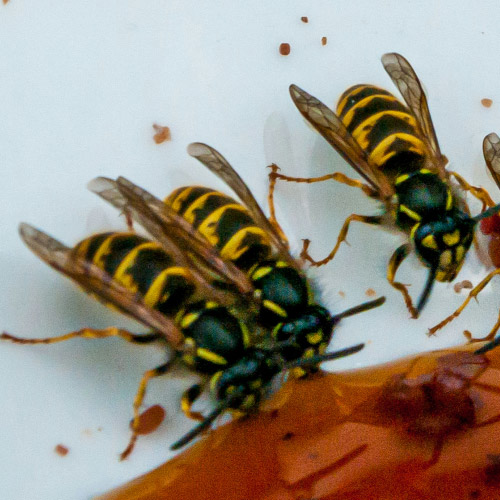
Dealing with wasp infestations requires careful consideration and we would strongly recommend you contact us to deal with any nests. Wasps, particularly the common wasp and the German wasp, can pose a threat to public health and safety, especially in late summer when their colonies are at their peak. DIY attempts to treat wasp nests are strongly discouraged due to the aggressive nature of these insects, unlike bees, wasps will sting multiple times and can cause severe allergic reactions in some individuals.
Treatment will involve the safe use of insecticidal dust or spray and specialist lances that can reach most nests without the need for ladders or specialist access equipment. Visible activity will cease within 12 hours of treatment.
When attending residential premises, we will always survey all buildings to identify if any other nests are active to save further callouts. Additional nests within the same premises are not uncommon. Read about our Wasp Removal Services
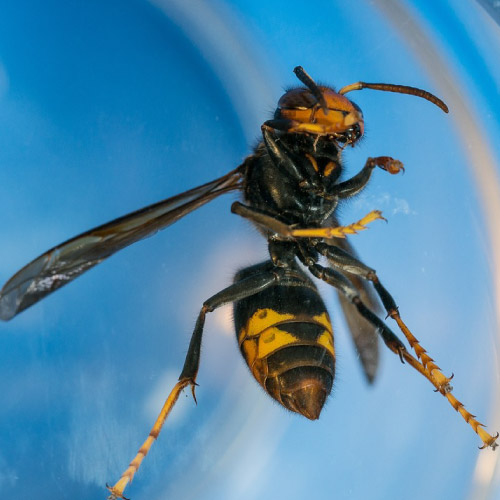
CRITICAL - The presence of Asian hornets, an invasive species native to Southeast Asia, has become a concerning issue in the UK. These hornets, which are smaller than the native European hornet, pose a critical threat to local ecosystems as well as honeybee populations. Identified by their distinctive orange faces and dark abdomens, Asian hornets are known for their predatory behaviour towards honeybees, preying on them and impacting pollination cycles. The UK has implemented monitoring and control measures to detect and manage their presence, as these hornets can establish colonies rapidly. Public awareness and reporting play a crucial role in tracking and mitigating the spread of Asian hornets.
PLEASE NOTE: If you see an Asian hornet between February and May it's likely to be a Queen and should be captured / terminated if safe to do so without any risk of injury. If you see Asian hornets between June and September, please do not kill them. They will be used to track and locate where the nest is located.
If you believe you have seen or captured an Asian hornet (taking a picture will help us significantly) please contact us at once.
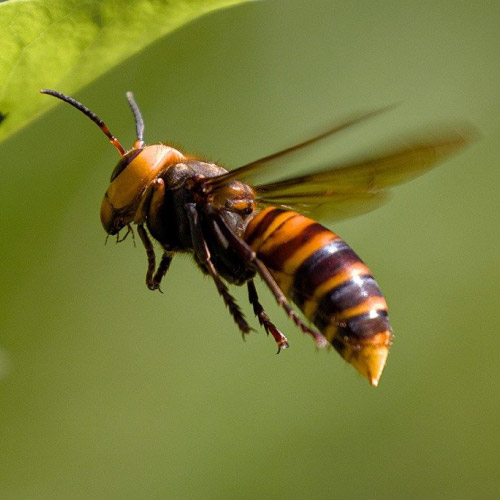
Treating European hornets requires a cautious and targeted approach to minimise risks. Identifiable by their robust size and distinctive brown and yellow colouration, European hornets are generally less aggressive than their Asian counterparts. In the case of a nest infestation near human activity, treatment is likely recommended. European hornets will become more prevalent in the late summer and autumn when they are attracted to artificial light.
Conservation-minded approaches also stress the importance of distinguishing between pest control and preservation, recognising the valuable role these hornets play in local ecosystems as pollinators and predators of other pests. Please call us without obligation to determine the most suitable and environmentally responsible course of action.
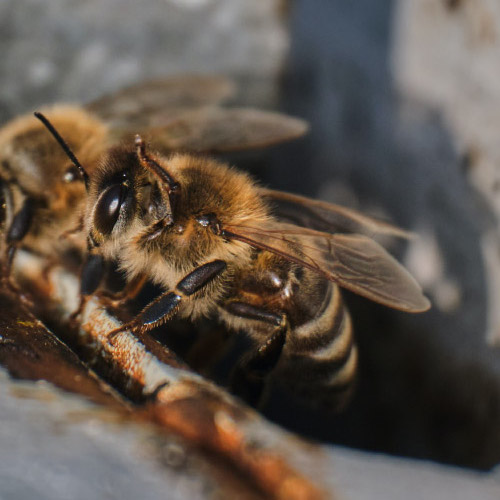
Bees are critical pollinators, as are Bats. There are numerous types of bees all performing a vital role in our ecosystem which we are all reliant on. 70% of the world's food supply comes from food sources requiring pollination. Bees are continually threatened by the actions of humans and consequently are in decline. Nests and sanctuaries should be left undisturbed wherever possible. Bees will be very active in spring and are frequently reported as wasps trying to nest in walls. In almost all cases it will be a species of solitary bee which do not sting and are non-destructive.
Bumble bees will have a range of nesting habits depending on the species (25 different types in the UK), the colony may well be in the ground and relatively small. The Queen and her workers will be active from early spring until August and we would strongly recommend that they are left to happily deliver pollinate and play their critical role.
Honey Bees have a natural tendency to swarm, typically occurring between April and July when a queen leaves her colony. The accompanying swarm of bees may seem intimidating due to their numbers, but rest assured, they are unlikely to pose a threat as their primary focus is on following their queen. Swarms usually settle on a bush, tree, or building structure while scouts search for a suitable new home. In most cases, swarms move on within 24 hours.
If you encounter a resting swarm, we can assist. As beekeepers (we are members of Newbury Beekeepers and an active member of the swarm collection team), we are equipped to collect and relocate swarms, ensuring a new home for them if they haven't dispersed before our intervention. Your prompt action can contribute to the safe and responsible management of these swarms. Call us on: 07404 824 300.
We are excited to offer you the unique opportunity to "adopt" your swarm for a year. For a small fee of £250+VAT, we will carefully relocate the swarm to one of our managed apiaries, providing meticulous care to nurture the bees. Our primary objective is to ensure the well-being of the colony and contribute to the preservation of these essential pollinators within the local environment.
Your valued and much-needed adoption contribution comes with a range of benefits, including:
We would be delighted to discuss further details and answer any questions you may have about the unique and rewarding experience of adopting your swarm in our apiaries.
We undertake honeybee colony relocations as opposed to terminations. Please feel free to contact us for guidance and assistance. We provide expert advice and conduct thorough consultations for relocation work, working with insurance companies where required to do so.
In certain cases, removal may involve collaboration with building contractors and the use of access equipment to ensure a safe and efficient process. Read about our Bee Removal Services.
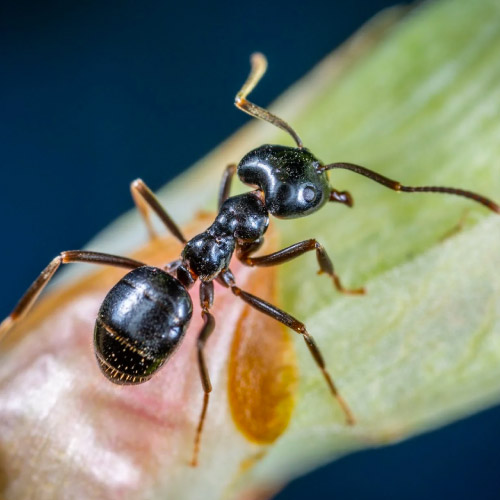
Garden Ants, Ghost Ants, and Pharaoh's Ants are common nuisances that often require specialised attention.
Garden Ants, with their vast colonies, can infiltrate both indoor and outdoor spaces. Applying boiling water to a nest should be undertaken with care and an understanding that the effectiveness of this method is unlikely to eradicate ant presence. Ant powders should be used with consideration to the wider ecosystem as they are indiscriminate and not target-specific. Please contact us for an obligation-free discussion on how infestations may be best dealt with. Ghost Ants, known for their elusive nature, demand a meticulous approach and treatment program once their presence has been confirmed following a premises survey.
Pharaoh's Ants, notorious for their resilience and ability to thrive in diverse environments, pose a unique challenge. A comprehensive pest control strategy for Pharaoh's Ants involves identifying nesting sites and implementing precision treatments, disrupting colonies at the source.
We prioritise environmentally friendly solutions to safeguard your surroundings while ensuring the long-term success of ant control programs ensuring value for money and your satisfaction.
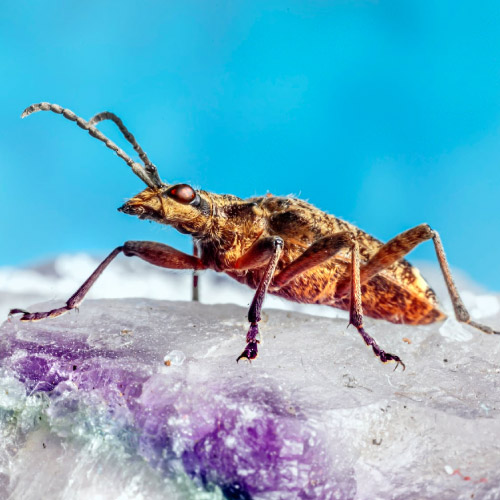
Several beetles in the UK damage buildings, furnishings, and food items. Among the primary culprits are Carpet Beetles, Furniture Beetles (woodworm), and Biscuit/Flour Beetles. While other beetle species may occasionally appear in commercial and domestic premises, they typically do not reach levels of significant concern or lead to substantial infestations. Control and treatment of beetles will be tailored to the client, premises and species. Please call us to discuss your needs, whether it's for infestation treatment or prevention, monitoring and reporting programs.
Carpet Beetles are problematic. The adult Carpet Beetle primarily feeds on pollen and nectar from garden flowers but lays eggs in various locations, including old birds' nests, felt, fabric, or accumulated fluff within buildings. It's the larvae that cause damage, feeding on feathers, fur, hair, or wool. These larvae, often referred to as "woolly bears," have surpassed clothes moths as a significant textile pest in the UK. The Variegated Carpet Beetle, measuring 2 to 4mm, resembles a small, mottled brown, grey, and cream ladybird. The related Fur Beetle is black with a distinctive spot on each wing case. Identifying and addressing infestations promptly is crucial for effective beetle control.
The Furniture Beetle, measuring between 2.5-5mm in length, is the adult stage of woodworm. It emerges from infested wood, typically between May and September, with a peak in activity during June and July, leaving distinct round exit holes ranging from 1-2mm in diameter. As specialists in Woodworm treatment, we take pride in our expertise and are an approved Sovereign Contractor. All our woodworm treatments come with a 30-year warranty, supported by an insurance-backed guarantee. For further details, please refer to our dedicated information on Woodworm.
Biscuit or Flour Beetles are widespread in the UK, frequently found in food storage and retail premises, and commonly encountered in domestic properties. These small reddish-brown insects, measuring only about 3mm in length, target stored foods in domestic cupboards and larders.
They are particularly attracted to a variety of stored items such as flour, biscuits, cake mixes, cereals, spices, meat, and soup powders. They can penetrate foil and lead and shelves of books. The small and active white larvae hatch and feed for about two months, depending on temperature. After pupating inside cocoons, often within the food material, the adult beetles emerge one or two weeks later, leaving exit holes that resemble typical 'woodworm' exit holes. The adults, which fly but do not feed, live relatively short lives, lasting three to four weeks. Mating occurs soon after emergence, contributing to the life cycle of these beetles.
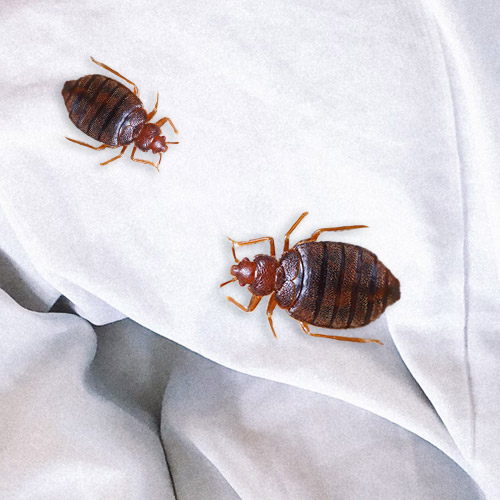
Bed bugs in your property are not a cause for embarrassment. Infestations often occur due to unforeseen circumstances rather than any negligence. These pests can easily transfer themselves through travel luggage, packaging, used furniture, or even clothing.
While bed bugs may harbour various pathogens, current evidence suggests that transmission to humans is unlikely and unproven. Despite the absence of known disease risks associated with bed bug bites, they can induce acute irritation and distress. Reactions to bed bug bites vary; some individuals develop red, irritating marks and lumps, while others may not react at all. The bites are often itchy, leading to painful swelling, and excessive scratching can result in infections.
Successful treatment of bed bug infestations necessitates the skilled application of specialised insecticides designed to overcome resistance to previously effective treatments. This process is both time-consuming and meticulous. Bed bugs show a tendency to lie dormant in various areas such as bed frames, mattresses, furniture, sockets, and luggage for extended periods, emerging when they detect carbon dioxide, often during sleep in bedrooms.
To effectively address an infestation, the treatment involves fully disassembling the contents of an infected room. The treatment applied will vary depending on factors specific to each infestation – e.g. structure of property, occupants, risk assessment results, and level of infestation. Textiles should be carefully placed into sealed plastic bags which we will provide. Clothing should be placed into our water-soluble plastic bags. Bags should be sealed within the infested area and transferred directly into a washing machine and put on a 60-degree cycle for a minimum of 1 hour. Textiles and items not suitable for hot washing can be deep-frozen for 2 days. These comprehensive measures are essential for eradicating bed bugs and preventing their resurgence.
We also supply and fit bed bug-proof mattress encasements following treatment for complete peace of mind. Remember, addressing a bedbug issue promptly is a common and manageable occurrence, and there's no stigma in seeking assistance to resolve it. Read about our Bed Bug Removal Services.
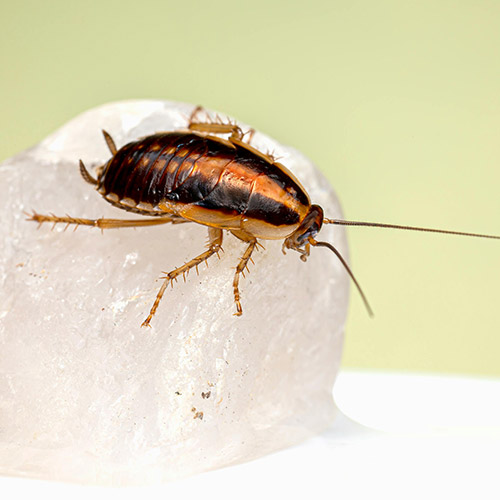
Cockroaches not only present a direct health risk but also act as vectors for diseases, carrying organisms responsible for various human ailments, including food poisoning. Known carriers of bacteria such as salmonella, staphylococcus, and streptococcus, these pests pose a serious threat to human health.
Their ability to traverse from sewers and drains into buildings heightens the risk. Once inside, cockroaches forage for food and water, contaminating anything they encounter—be it food, utensils, or preparation surfaces. The issue is compounded by their habit of disgorging portions of partially digested food at intervals and leaving faecal matter along their path. This unsanitary behaviour underscores the urgency of effective cockroach control to safeguard the health and hygiene of a living or working environment.
There are around 4,600 species globally, with several present in the UK. Among the most common are the German cockroach and Oriental cockroach. Occasionally, the American cockroach and Brown-banded cockroach may be seen. Understanding the distinct characteristics and habitats of these species is crucial for effective pest control and prevention.
Although cockroaches are typically nocturnal identifying signs of their presence is crucial for early detection and effective control. Look out for indicators such as droppings, egg (ootheca) cases, shed skins, an unpleasant odour (especially in large infestations), and damage to food or packaging.
If any of these signs are observed, prompt action is advised. Early intervention can prevent the escalation of an infestation, protecting property and businesses and ensuring a healthier, more hygienic environment. Don't hesitate to contact us to discuss and schedule a thorough inspection and targeted treatment if signs of cockroach activity are detected.
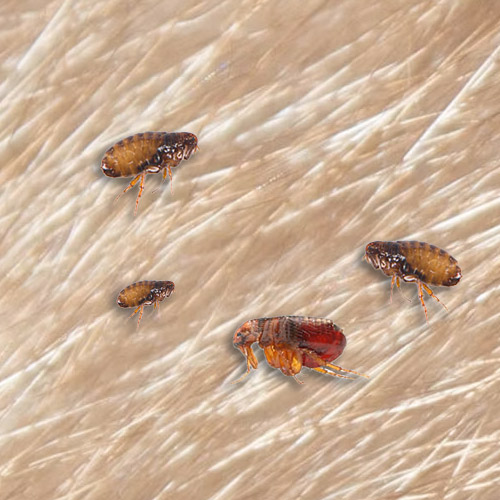
Controlling fleas in the UK requires a thorough and targeted approach due to their rapid reproduction and resilience. Fleas are common and will successfully reproduce in any premises where soft furnishings, warmth and a food host are provided. Typically the source of fleas is Cats and Dogs. Fleas can also lie dormant for extended periods. If you are moving into a property that has previously had cats or dogs and has been vacant for some time, a precautionary flea treatment is recommended before occupation.
Before, during, and after flea treatment, it's essential to follow a systematic approach to ensure effectiveness and safety. Here's a step-by-step guide:
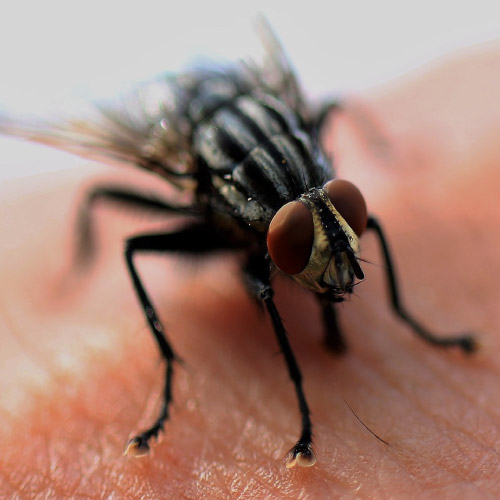
Controlling flies involves a combination of preventive measures, hygiene practices, and targeted treatments. Fly papers and aerosol insecticides used following the manufacturer’s instructions will assist with the control of flies in domestic properties. Commercial premises and production environments should introduce a managed control programme with frequent monitoring.
We have many years of experience working with commercial enterprises, local authorities, and education establishments in implementing, servicing, and reporting programs. Our expertise includes correctly installing (positioning is critical) and maintaining state-of-the-art fly control methods, including electronic fly killers, ensuring comprehensive and effective fly management solutions for our clients.
Dealing with cluster flies often involves a combination of preventive measures and targeted treatments. Cluster flies are known for gathering in large numbers in buildings, especially during the cooler months, seeking shelter to hibernate. Infestations in south-facing windows can present themselves in significant volumes and are very unpleasant. Cluster flies will typically need treating annually due to the lifecycle of offspring returning to the same building. All premises will require a survey before treatment to check for the presence of bats.
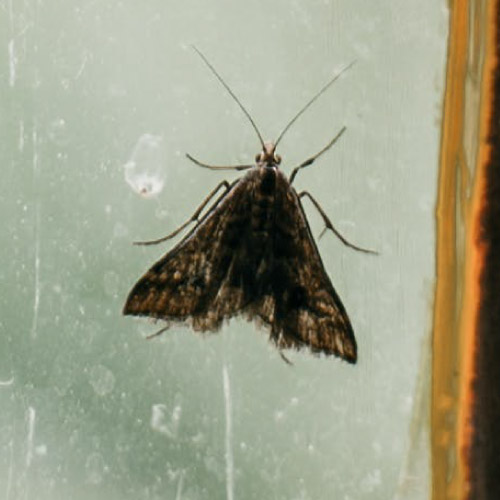
Carpet/Clothes/House Flies - The most prevalent among the so-called clothes moths is characterized by its distinctive golden-bronze wings, speckled with black and folded flat along its back. Measuring approximately 8mm in length, the adult prefers running to flying.
The Brown House Moth, reaching lengths of up to 18mm, feeds on a variety of materials, including wool, hair, fur, feathers, cork, and debris from food like dried fruit or cereals. Commonly found in old birds' nests, they may enter buildings from these nesting sites.
A closely related species, the White Shouldered House Moth, has mottled wings with a white head and "shoulders" where the wings join the body. The eggs of this moth are affixed to fabrics, serving as a food source for the larvae. These larvae, creamy-white caterpillars with brown heads, spin silken cocoons for pupation which are similar in appearance to long-grain rice. They are typically found under furniture in rooms with woollen-rich fabrics where they consume the protein present in the fibres.
The life cycle of these moths spans several months, with only the larval stage being an active feeder. As both general scavengers and textile pests, their presence can be problematic, making effective pest control measures essential for protection against damage to fabrics and textiles.
Treating and controlling moths is tailored to the species, premises, and environmental conditions. For domestic infestations, knockdown and residual insecticides will be considered as part of an Integrated Pest Management Programme. We typically recommend the use of seasonal lures to establish the presence of invasive species before they become a problem. We are highly experienced in implementing and managing control programs for production environments.